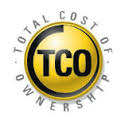The concept of total cost of ownership or “TCO” is to determine a product’s true cost not just based on the price but on all the costs it takes to purchase and maintain the product during the entire time it is owned. This is hardly a new concept and most of us apply it in our personal lives, knowingly or not, each time we make a major purchase. For example, when we buy a car we want to know the price of the new car, the trade in allowance on our old car, the taxes at time of purchase, ongoing taxes and insurance, gas mileage, maintenance costs, and maybe even the amount we can sell it for when we are ready for another. In fact, almost all of the on-line car research sites (Edmunds, Kelly Blue Book, and Consumer Reports to name a few) calculate the expected TCO for about every model out there. There is little doubt that TCO is an effective tool when making a purchase decision on a major, long-lived asset…but is the concept equally effective when comparing competing offers from material suppliers?
all the costs it takes to purchase and maintain the product during the entire time it is owned. This is hardly a new concept and most of us apply it in our personal lives, knowingly or not, each time we make a major purchase. For example, when we buy a car we want to know the price of the new car, the trade in allowance on our old car, the taxes at time of purchase, ongoing taxes and insurance, gas mileage, maintenance costs, and maybe even the amount we can sell it for when we are ready for another. In fact, almost all of the on-line car research sites (Edmunds, Kelly Blue Book, and Consumer Reports to name a few) calculate the expected TCO for about every model out there. There is little doubt that TCO is an effective tool when making a purchase decision on a major, long-lived asset…but is the concept equally effective when comparing competing offers from material suppliers?
Unequivocally, the answer to this question is YES!
Costs to Consider when Applying TCO to Material Purchases
If the goal is to find the lowest total cost for a given type of material or subassembly, we must consider more than just the price the supplier is charging. Only by taking into consideration all the costs of acquiring and owning can we really determine which supplier is offering the lowest cost alternative. Below are various costs that normally should be considered as part of a TCO analysis in addition to the price paid.
- Selection Costs. These are the costs associated with selecting and vetting a supplier. They include the cost of bidding and also the cost of approving a supplier.
- Acquisition Costs. These are the costs associated with placing an order with a given supplier.
- Shipping Costs. These are the costs of getting the material from your supplier to your factory.
- Receiving Costs. These are the costs of receiving and putting away the material in your factories stock room.
- Carrying Costs. These are the costs associated with carrying the material in your inventory. These costs include the cost of financing inventory, insuring inventory, maintaining inventory (cycle counts, etc.), warehousing inventory (rent, utilities, taxes, etc.).
- Obsolescence Costs. These are the costs of inventory loss due to shrinkage and obsolescence.
Although each of these “ownership costs”, can vary significantly depending on a large number of factors, it is not at all uncommon for these costs when taken together to be higher than the price paid for the material in the first place. So if the goal is really to get the lowest total cost not just the lowest price, each of the ownership costs must be considered. But how can you and your company successfully attack ownership costs? In the answer to this question lies the path to lowest total cost.
Time to Get Serious about Partnering
A variety of tools from demand pull production systems to kanban inventory replenishment programs can help control and reduce ownership costs. In fact, the low hanging fruit with most lean initiatives is to reduce inventory. The thought being that by reducing inventory, the ownership costs will necessarily be reduced at the same time.
Whatever the systems adopted or tools employed, the only way to significantly reduce ownership costs and lower TCO is to develop partners in your supply chain. Experienced supply chain partners can work with you to devise programs to minimize ownership costs throughout the supply chain not just shift them to another payer. This creates an opportunity for win-win scenarios; scenarios that greatly reduce your firm’s TCO while allowing your partners to earn a fair margin.
Now let’s look back at the ownership costs listed above but now with some programs that when applied with a good supply chain partner can help reduce each.
- Selection Costs. Put in place that contacts and reduce bidding. Consider the cost of vetting a supplier in the first place. For example, the cost of approving (visiting, auditing, etc.) a supplier in Asia is a lot higher than approving one in Mexico.
- Acquisition Costs. Consider auto-replenishment (kanban or vendor managed inventory) and payment systems. Link your MRP to that of your supplier so that ordering is automated.
- Shipping Costs. Consolidate more business through fewer suppliers so that shipments can be consolidated without running up overall inventory investment.
- Receiving Costs. Vet your best suppliers and implement dock-to-stock programs. Have these same suppliers pre-label for put-away. Or better still implement a kanban program and go direct from dock-to-factory floor.
- Carrying Costs. Minimize inventory through demand pull production systems and kanban replenishment.
- Obsolescence Costs. Again, minimize inventory through demand pull production and kanban replenishment. Work with design engineers to use commonly available components in the design and to avoid using components that are known to be late in their life cycle.
The bottom line is that low price should not be the goal; the focus should be on lowest total cost. And the only way to achieve lowest total cost is to partner with a few key, reliable suppliers.
About the Author
 David Copenhaver is President of RESCO Electronics, a Baltimore based manufacturer electronic assemblies and value added reseller of auto ID equipment to original equipment manufacturers. Before joining RESCO in 2003, David was the Senior Vice President of Operations and member of the Board of Directors for US Office Products, a publicly traded distributor of office products that is now part of Staples. Beginning in 1989, David co-owned and managed The Smith-Wilson Co., an Orlando based distributor of office products that was sold to US Office Products in 1996.
David Copenhaver is President of RESCO Electronics, a Baltimore based manufacturer electronic assemblies and value added reseller of auto ID equipment to original equipment manufacturers. Before joining RESCO in 2003, David was the Senior Vice President of Operations and member of the Board of Directors for US Office Products, a publicly traded distributor of office products that is now part of Staples. Beginning in 1989, David co-owned and managed The Smith-Wilson Co., an Orlando based distributor of office products that was sold to US Office Products in 1996.
David has a Bachelor of Science in Electrical Engineering and a Masters in Business Administration both from the University of Virginia. He is married and lives in Arlington, Virginia with his wife and three sons.

